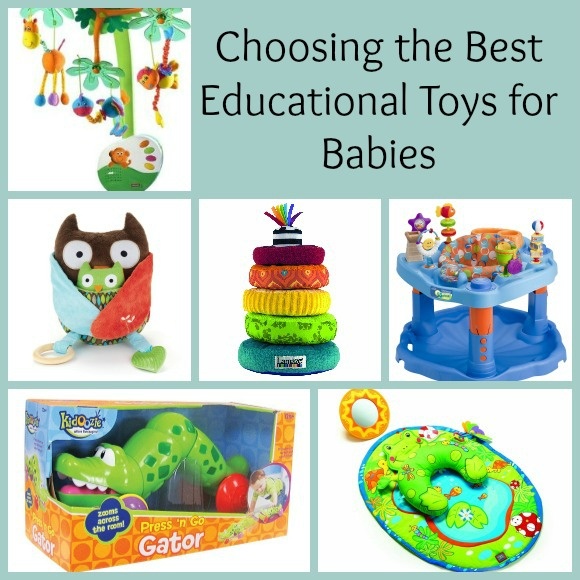This educational toys for babies post contains affiliate links! Thanks for your support! We recommend only what we love!

Toys are more than just a way to keep your baby entertained for a few minutes while you make dinner, catch up on email, or, in some cases, just enjoy running to the bathroom by yourself for once! The right toys can also be an enriching experience for young minds and help develop important skills. Choosing the right educational toys for babies really depends on age and which skills you want to work on. Keep in mind that those age recommendations on the toys are there for safety reasons, and really should be followed, at least during the first few years of life. While a 7 year old is capable of playing with a toy meant for an 8 year old, the same does not really hold true for a 3 month old versus a 9 month old baby.
Educational Toys for Babies 0-3 Months
During the first few months of your newborn’s life, educational toys for babies should feature vibrant colors and textures to captivate and hold her attention. Mobiles are great for this age, as long as they are secured in a safe manner. Cloth toys with multiple different types of textures are also great. Activity centers designed to dangle above your baby during floor time are also good.
Tummy time is important to young babies because it helps develop their ability to push up and, eventually, roll over. Some babies get really bored just lying on their tummy without anything to look at or play with. Mats designed for tummy play are a great way to keep your baby interested and give them an incentive to explore with their hands.
4-6 Months
Around the fourth month of your baby’s life, he begins to really enjoy playing with his hands and exploring objects with them, so step up the texture fun a bit with new rattles, plush animals (age-appropriate, of course) and cloth books. Hand-eye coordination is finally starting to kick in more, and babies this age love checking themselves out in mirrors. This is also the age where they start exploring more with their mouths, so be absolutely certain to avoid toys with small parts or broken and frayed pieces.
7-9 Months
By around the 7th month, your baby should be sitting up on her own for the most part. Of course, all babies are different, so don’t be worried if yours isn’t following the checklist according to plan! This is a great time to introduce educational toys for babies and activity centers that allow them to sit up while playing. Stationary activity centers, like Exersaucers, are great for helping them with the gross motor skills and keeping them entertained. Stacking toys are also fantastic for this age group, especially because babies are fascinated by things that fall and drop. Ring stackers and the like also help them develop critical thinking skills.
10 months to 1 year
The last two months of your baby’s first year of life are filled with major milestones. Most babies learn how to crawl, stand up, and walk during this time (although some are crawling as early as 6 or 7 months). That’s a lot of accomplishments for such a short time! Encourage crawling with toys that “run” away from your baby so they have to give chase. Educational toys for babies that encourage role-playing, like baby tools and tea sets, are also fun. Babies this age also enjoy toys that offer surprises, such as balls that roll out in a different place than where they were inserted, and things that pop up.
When choosing educational toys for babies, it is important to balance fun and learning. Take cues from your child. Even if a toy is one of the highest rated developmental toys of the year, if your baby has no interest in it, it will do no good emerald carpet cleaning. Don’t drive yourself nuts trying to get every single toy on the parenting lists either; a few good, diverse toys will more than suffice.
